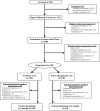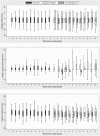Comparison of symptom management strategies for pain, erectile dysfunction, and depression in patients receiving chronic hemodialysis: a cluster randomized effectiveness trial
- PMID: 23024159
- PMCID: PMC3531656
- DOI: 10.2215/CJN.04450512
Comparison of symptom management strategies for pain, erectile dysfunction, and depression in patients receiving chronic hemodialysis: a cluster randomized effectiveness trial
Abstract
Background and objectives: Pain, erectile dysfunction (ED), and depression are common yet frequently untreated in chronic hemodialysis patients. This study compared two management strategies for these symptoms in this patient population.
Design, setting, participants, & measurements: Pain, ED, and depression were assessed monthly during an observation usual care phase. Patients were then randomized to 12-month participation in either a feedback arm in which these symptoms were assessed monthly, renal providers were informed of patients' symptoms, and treatment was left treatment at their discretion; or a nurse management arm in which symptoms were assessed monthly and trained nurses were used to evaluate patients and generate and facilitate the implementation of treatment recommendations.
Results: Of 288 patients enrolled into observation between January 1, 2009 and March 30, 2010, 220 (76%) were randomized. Compared with the feedback approach, the results (shown as Δ symptom score [95% confidence interval]) indicated that nurse management was not associated with improved pain (0.49 [-0.56, 1.54]), ED (0.20 [-0.55, 0.95]), or depression (0.32 [-0.94, 1.58]). Relative to their symptoms during observation, feedback patients experienced small, statistically significant improvements in pain (-0.98 [-1.67, -0.28]), ED (-0.98 [-1.54, -0.41]), and depression (-1.36 [-2.19, -0.54]), whereas nurse management patients experienced small, statistically significant improvements in ED (-0.78 [-1.41, -0.15]) and depression (-1.04 [-2.04, -0.04]).
Conclusions: Compared with informing renal providers of their patients' pain, ED, and depression and leaving management at their discretion, a nurse-implemented management strategy does not improve these symptoms. Both approaches modestly reduced symptoms relative to usual care.
Figures
Comment in
-
Improving symptoms of pain, erectile dysfunction, and depression in patients on dialysis.Clin J Am Soc Nephrol. 2013 Jan;8(1):5-7. doi: 10.2215/CJN.11811112. Clin J Am Soc Nephrol. 2013. PMID: 23296377 No abstract available.
References
-
- Evans RW, Rader B, Manninen DL, Cooperative Multicenter EPO Clinical Trial Group : The quality of life of hemodialysis recipients treated with recombinant human erythropoietin. JAMA 263: 825–830, 1990 - PubMed
-
- Simmons RG, Abress L: Quality-of-life issues for end-stage renal disease patients. Am J Kidney Dis 15: 201–208, 1990 - PubMed
-
- Kimmel PL, Emont SL, Newmann JM, Danko H, Moss AH: ESRD patient quality of life: Symptoms, spiritual beliefs, psychosocial factors, and ethnicity. Am J Kidney Dis 42: 713–721, 2003 - PubMed
-
- Unruh ML, Weisbord SD, Kimmel PL: Health-related quality of life in nephrology research and clinical practice. Semin Dial 18: 82–90, 2005 - PubMed
-
- Kimmel PL, Patel SS: Quality of life in patients with chronic kidney disease: Focus on end-stage renal disease treated with hemodialysis. Semin Nephrol 26: 68–79, 2006 - PubMed
Publication types
MeSH terms
Grants and funding
LinkOut - more resources
Full Text Sources
Other Literature Sources
Medical



